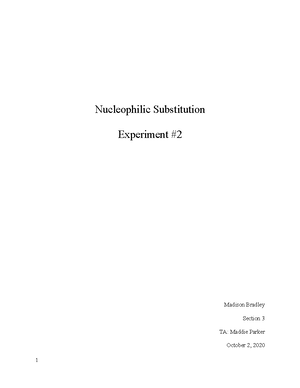

Title: Furoin Condensation Purpose: The purpose of this lab is to obtain furfural from corn cobs. The furfural will then be converted to furoin using thiamine as a biomimetic catalyst for nucleophilic addition of a carbanion to an aldehyde. IR, 1 H NMR, and melting point will be used to analyze the identity and purity of the product. References: Friedstad, G. Techniques & Experiments in Organic Chemistry: Biological Perspectives & Sustainability; W. Norton: New York, 2023. CHEMnetBASE; Taylor & Francis Group. ccdchemnetbasecom.proxy.lib. edu/chemical/ChemicalSearchResults?dswid=1807. (accessed 2024-02-18). Chemical Properties and Safety Guidelines: name MW (g) d (ρ/g cm-3) mp (°C) bp (°C) amount fp (°C) toxicity sodium chloride 58 2 802 1465 15g toxic HCl 36 -114 -85 75mL (3M) corrosive, toxic, irritant NaOH 39 2 323 1390 0 (2M) toxic, corrosive CH 2 Cl 2 84 1 -94 40 4mL explosive, irritant Na 2 SO 4 142 2 884 furfural 96 1 -37 162 0 flammable, irritant thiamine hydrochlorid e 337 248 0 ethanol 46 0 -114 78 5mL 13 flammable, irritant, toxic furoin 192 135 10mg
Equipment: Flowchart: 1. Set up for simple distillation; turn on the cooling water set to slowest setting; place a heat source on a lab jack and set to medium heat 2. Add 15g of corn cobs ground to kernel-sized pieces, 15g sodium chloride, and a boiling chip to a 200mL round-bottom flask 3. Clamp the flask and add 75mL 3M HCl solution 4. Attach the flask to the distillation setup and heat on high heat until boiling begins; lower the heat to a setting that maintains consistent distillation 5. Distill until ~20mL distillate is collected 6. Lower the heat source away from the flask and turn off 7. Remove the collection flask from the setup; add 2M aqueous NaOH dropwise to the distillate while swirling the flask; check the acidity with pH paper; continue adding NaOH dropwise until the mixture is around a pH 4-6; if the acidity rises above 6, add a drop of aqueous 3M HCl solution to bring it back down 8. Pour the mixture into a separatory funnel; rinse the flask with 2 1mL portions of CH 2 Cl 2 , adding each to the funnel; swirl then drain the bottom organic layer into a 25mL flask; extract the aqueous phase with 2 1mL portions of CH 2 Cl 2 adding the extracts to the same flask